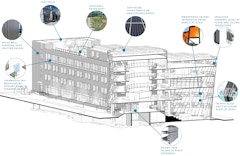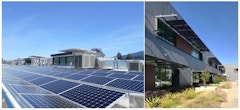16 results
-
Wearables protect us from climatic conditions, they provide privacy, comfort and they also reflect our style and personality. Building facades in the…
-
Reglaze or Replace?
- Paper by Angel Ayón, AIA, LEED AP, Principal Laura Boynton, AIA, LEED AP, Senior Associate
Originally known as The Master Building, 310 Riverside Drive in Manhattan's Upper West Side is a 28-story tower completed in 1929 as an apartment… -

Impact Of Thermal Bridges On The Energy Response Of A Building
- Paper by Ilaria Sebastiani · Riccardo Pinotti · Stefano Avesani · Simone D’Amore · Stefano Pampanin
The European building stock is mainly constituted by highly energy demanding buildings. The only way to a more sustainable and decarbonized building
-

Sustainable Retrofit Strategies for an Existing Laboratory Building
- Paper by Suncica Milosevic · Ajla Aksamija
This paper analyzes sustainable retrofit strategies for an existing research laboratory building, located in a cold climate. This facility is
-

Passively Actuated Systems
- Paper by Manuel Benitez Ruiz · David Gerber
Kinetic or responsive facades have been developed to improve buildings' daylighting conditions while mitigating energy consumption. Still, these
-
Adaptive Reuse of Industrial Heritage Façades
- Paper by Bahar Basarir, PhD, PhD from Research Assistant to Assistant Professor Hatice Yasemin Cakir, Research Assistant
With the developments in production, industrial facilities lost their function and were abandoned over time. The most frequent and often the most… -
Xilinx Case Study
- Paper by Michael Martinez, LEED AP · Stet Sanborn, AIA, LEED AP, CPHC
The transformation of a dark and inhumane 1970s tilt-up concrete office building into a high performance, light-filled modern workplace was enabled
-

Seismic Movements
- Paper by Gijs Libourel · Daniel Segraves
A common building upgrade to add value to existing commercial real estate is the renewal of the entrance lobby. The lobby facade is replaced to give
-

Retrofit Options for Historic Facades
- Paper by Carrie Davis, P.E., LEED Green Assoc., George Kantrales, Ph.D., Matt Barsotti, Andrew Schoenheit, Ty Vandergriff,
Building design criteria requires that government buildings be designed for a variety of extreme loads including blast, hurricane, and impact… -
Challenges of Tall Iconic Building Retrofit
- Paper by Hamid Vossoughi, P.E., P. Eng.
Change happens, for better or for worse, to all living and physical matter. In order to thrive and achieve longevity, we constantly need to adapt to
-

Adaptable Glazing Shields
- Paper by Anas Al Kassas
Today, about 40% of all buildings in the U.S. still have single-pane windows, and ~70% of the existing building stock is estimated to suffer from
-

Slipping through the Cracks
- Paper by Jason Siwek P.E.
We construct building enclosures to keep the elements out, but sometimes air and water infiltrate the building envelope, causing several problems for
-

The Evolution of AEC Professional Silos
- Paper by David Olsen, AIA · Megan Leon, P.E. · Christopher Chiuchiolo, LEED AP · Andrea Bono, P.E., LEED AP BD+C · Nick Rustia, P.E. · Diane T Sands, MLIS, MFA, MS-GIST
Healthcare projects in northern California require specialized knowledge to navigate regulation, technological advancements, and project execution
-

Detailing For Distance
- Paper by Daniel Kelso,
Quickly exceeding new facade service life expectations for tall buildings imposed by increasing environmental, economic, and social pressures have… -

Doubling Mies
- Paper by Timothy Brown AIA NCARB CSI, Associate Professor
Mies van der Rohe’s concurrently designed projects for Commonwealth Promenade Apartments (1953-1956) and the Esplanade Apartments (1953-1957), saw… -

Preserving a Historic Facade
- Paper by Maria Mohammed, S.E. · John Fidler, RIBA, Intl Assoc AIA, FRICS, FSA, FRSA, FIIC, FAPT
Environmental and socio-economic benefits of sustainable preservation have become apparent most recently in the restoration of the historic former

